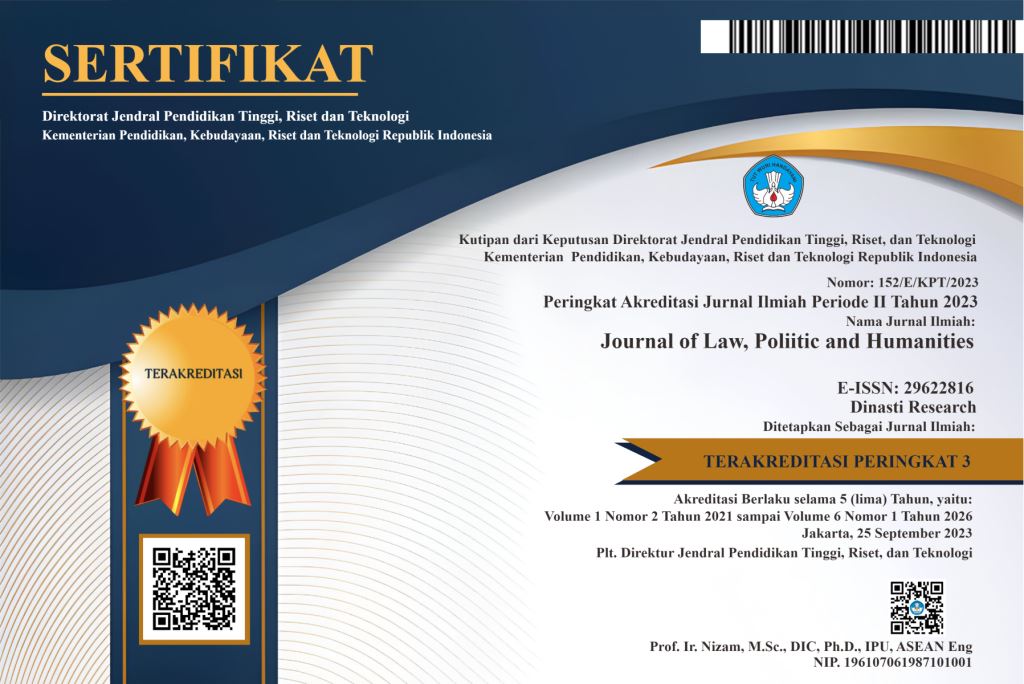Problematics of Qibla Direction Determination in Sei Lepan Brandan District, Langkat Regency (Analysis of MUI Fatwa No. 5 of 2010 on the Amendment of MUI Fatwa No. 3 of 2010)
DOI:
https://doi.org/10.38035/jlph.v4i3.341Keywords:
Fatwa of the Indonesian Ulema Council and Qibla DirectionAbstract
Qibla direction has always been a special concern of the MUI Fatwa Commission. With this paper, it is intended to find out something that has been behind the problem of determining the Qibla direction with the issuance of the Indonesian Ulema Council Fatwa No. 5 of 2010 on the Amendment of the Indonesian Ulema Council Fatwa No. 3 of 2010. This research uses qualitative field research (Field Research) and library research (Library Research), in an analytical descriptive method. The results of the study inform that a change in the fatwa of the Indonesian Ulema Council that has been related to the Qibla position needs to be addressed reasonably. A change that occurs only in a third dictum is that changes the position of the West to the Northwest which is the Qibla of Indonesian Muslims. The first fatwa number 03/2010 only used a fiqh approach, while the next fatwa number 05/2010 used a fiqh approach, astronomy science, and falak science. In addition, determining the Qibla position is not difficult if it is carried out with an expert, even anyone can do it even in a simple way, namely Rashdul Qiblah. Therefore, calculating the Qibla position which is essentially a calculation that aims to determine the position of the Kaaba of Mecca from a position on the surface of the earth today which then every person who has performed prayers, either with a condition that is standing, ruku', or prostration which is always in a position towards the ka'bah.
References
Ardliansyah, M. F. (2017). Korelasi Fikih dan Sains dalam Penentuan Arah Kiblat. MASLAHAH (Jurnal Hukum Islam Dan Perbankan Syariah), 8(1), 13–30.
Arifuzzaky, M. (2017). Telaah Matematis Penentuan Arah Kiblat dengan Metode Spherical Trigonometry dan Metode Navigasi. Skripsi S1 UIN Sunan Kalijaga Yogyakarta.
Awaluddin, M., Yuwono, B. D., & Wicaksono, S. (2016). Kajian Penentuan Arah Kiblat Secara Geodetis. Teknik, 37(2), 84–87.
Budiwati, A. (2016). Tongkat istiwa ‘, global positioning system (gps) dan google earth untuk menentukan titik koordinat bumi dan aplikasinya dalam penentuan arah kiblat. Al-Ahkam, 26(1), 65–92.
Bukhari, T. (2021). Implementasi Fatwa Majelis Ulama Indonesia Tentang Pedoman Pengurusan Jenazah Muslim Yang Terinveksi Covid-19 Di Rsu Tangerang Selatan. Fakultas Syariah dan Hukum UIN Syarif Hidayatullah Jakarta.
Faiz, A. B. D. K. (2020). Moderasi Fiqh Penentuan Arah Kiblat: Akurasi Yang Fleksibel. JIL: Journal of Islamic Law, 1(1), 83–99.
Falak, U. M. G. M. I. (n.d.). Studi Kritik Terhadap Penentuan Arah Kiblat Dan Awal Bulan Qamariyah Pemikiran Kh. Ahmad Dahlan.
Husna, N. F. (2021). Posdaya Berbasis Masjid Pada Masjid AlMustafiq Di Kelurahan Bunga Tanjung Kota Tanjung balai. Universitas Islam Negeri Sumatera Utara.
Izzuddin, H. A. (n.d.). Metode Penentuan Arah Kiblat Dan Akurasinya 424.
Kuswidi, I. (2003). Aplikasi Trigonometri dalam Penentuan Arah Kiblat. UIN SUNAN KALIJAGA.
Lestari, R. A. Y. U. (n.d.). Respons Masyarakat Terhadap Kalibrasi Dan Perubahan Arah Kiblat Masjid At-Taqwa Desa Sawojajar Kecamatan Wanasari Kabupaten Brebes.
Marpaung, W. (2015). Pengantar Ilmu Falak. Prenada Media.
MUBAROK, M. H., & ASY-SYAKHSIYYAH, A.-A. (n.d.). PEMIKIRAN ALI MUSTAFA YAQUB TENTANG ARAH KIBLAT.
Mujab, S. (2016). Kiblat Dalam Perspektif Madzhab-Madzhab Fiqh. YUDISIA: Jurnal Pemikiran Hukum Dan Hukum Islam, 5(2).
Muslifah, S. (2011). Metode Penentuan Arah Kiblat Masjid Agung At Taqwa Bondowoso Jawa Timur. Skripsi Tidak Dipubli¬ Kasikan). Institut Agama Islam Negeri Walisongo, Semarang.
Mustaqim, R. A. (2020). Analisis Metode Penentuan Arah Kiblat Masjid Agung Baitul Makmur Meulaboh Aceh Barat. AL-MARSHAD: Jurnal Astronomi Islam Dan Ilmu-Ilmu Berkaitan, 6(2), 181–194.
Musthofa, A. (2019). Realisasi Pelaksanaan Fatwa MUI No. 5 Tahun 2010 Tentang Arah Kiblat Masjid di Kecamatan Medan Tembung. Universitas Islam Negeri Sumatera Utara.
Nabila, J. (2021). Hadis Dan Teknologi: Penentuan Arah Kiblat Ali Mustafa Yaqub Dan Dr. Ing. Khafid. Fu.
Nafi, A. Y. (2016). Verifikasi fatwa MUI nomor 03 tahun 2010 tentang arah kiblat. Mahkamah: Jurnal Kajian Hukum Islam, 9(1).
Nur, J., & Huzaimah, N. A. (2020). Akurasi Arah Kiblat Masjid–Masjid di Kota Kendari. Al-’Adl, 13(2).
Nurmila, I. (2017). Metode Azimuth Kiblat dan Rashdul Kiblat dalam Penentuan Arah Kiblat. Istinbath| Jurnal Penelitian Hukum Islam, 15(2), 191–212.
Pratiwi, P. (2020). Dinamika fatwa Majelis Ulama Indonesia tentang aborsi dan penggunaan vaksin meningitis dalam merespons perubahan sosial. Penerbit A-Empat.
Qulub, S. T., & Munif, A. (2023). Urgensi Fatwa dan Sidang Isbat dalam Penentuan Awal Bulan Kamariah di Indonesia: The Urgency of Fatwa and Isbat Assemblies in Determining the Beginning of the Month of Kamariah in Indonesia. Jurnal Bimas Islam, 16(2), 423–452.
Rahayu, D., & Ukhti, L. (2022). Uji Akurasi Arah Kiblat Menggunakan Azimut Bulan Purnama. Astroislamica: Journal of Islamic Astronomy, 1(1), 1–20.
Rokim, S. (2020). Tafsir Sahabat Nabi: Antara Dirayah Dan Riwayah. Al-Tadabbur: Jurnal Ilmu Al-Qur’an Dan Tafsir, 5(01), 75–94.
Suleman, F. (2016). Problematika Arah Kiblat. Jurnal Ilmiah Al-Syir’ah, 9(1).
Tanjung, D. (2018a). Ilmu Falak?: Kajian Akurasi Arah Kiblat Kota Medan, Metode dan Solusi. Medan: Perdana Publishing.
Tanjung, D. (2018b). Urgensi Kalibrasi Arah Kiblat dalam Penyempurnaan Ibadah Salat. Al-Manahij: Jurnal Kajian Hukum Islam, 11(1), 113–132.
Utami, T. P. (2020). Akurasi arah kiblat masjid kuno di Kabupaten Lombok Timur menggunakan istiwa’ani. UIN Mataram.
Yani, S. (2020). Analisis akurasi arah kiblat menggunakan kompas suunto oleh pembimbing syariah KANWIL kementerian agama provinsi Nusa Tenggara Barat. UIN Mataram.
Downloads
Published
How to Cite
Issue
Section
License
Copyright (c) 2024 Annisa Mawarni, Dhiauddin Tanjung

This work is licensed under a Creative Commons Attribution 4.0 International License.
Authors who publish their manuscripts in this journal agree to the following conditions:
- The copyright on each article belongs to the author(s).
- The author acknowledges that the Journal of Law, Poliitic and Humanities (JLPH) has the right to be the first to publish with a Creative Commons Attribution 4.0 International license (Attribution 4.0 International (CC BY 4.0).
- Authors can submit articles separately, arrange for the non-exclusive distribution of manuscripts that have been published in this journal into other versions (e.g., sent to the author's institutional repository, publication into books, etc.), by acknowledging that the manuscript has been published for the first time in the Journal of Law, Poliitic and Humanities (JLPH).


























